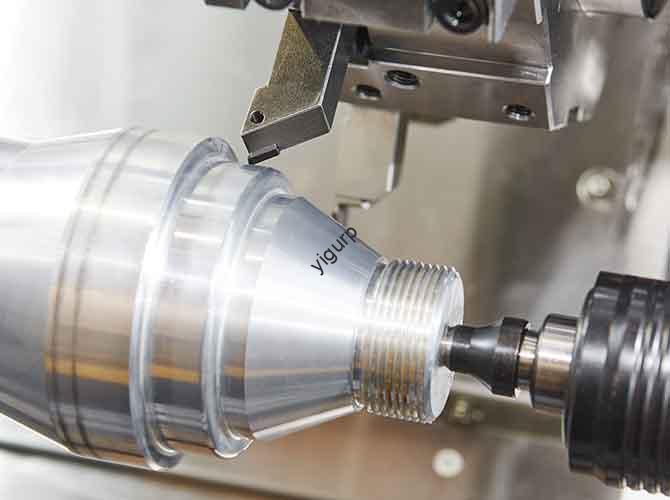In precision manufacturing, how do engineers consistently produce spherical parts with tight tolerances (often within 0.005mm)? The solution lies in CNC lathe ball head processing—a computer-controlled technique that turns raw materials into high-accuracy spherical components. This article guides you through its core principles, пошаговый рабочий процесс, critical tips, реальные приложения, и будущие тенденции, helping you avoid common pitfalls and boost production efficiency.
What Is CNC Lathe Ball Head Processing?
CNC lathe ball head processing refers to the use of Computer Numerical Control (Сжигание) lathes to machine workpieces into spherical (ball head) формы. Unlike manual lathe operations—where precision depends entirely on the operator’s skill—this method uses pre-programmed code to control tool movement, ensuring uniform accuracy across every part.
По своей сути, the principle is straightforward: A CNC system interprets a digital design (НАПРИМЕР., CAD -файл) and directs the lathe’s tool to cut the workpiece along a preset spherical trajectory. This eliminates human error and enables repeatable production of complex spherical parts.
Step-by-Step Workflow of CNC Lathe Ball Head Processing
Follow this linear, actionable process to achieve consistent results. Each step builds on the previous one—skipping any can lead to defective parts or machine damage:
- Программирование: Use professional CNC software (НАПРИМЕР., Мастеркам, и) to write the machining program. Введите параметры ключа:
- Spherical dimensions (диаметр, radius, терпимость).
- Тип инструмента (НАПРИМЕР., carbide turning tools for hard metals).
- Cutting path (Чтобы избежать столкновений инструментов).
Почему это важно: A flawed program will result in parts that don’t meet design specs—even with a top-tier lathe.
- Заготовка заготовки: Закрепить сырье (НАПРИМЕР., алюминий, сталь) to the lathe’s chuck or fixture.
- Ensure positioning accuracy (use a dial indicator to check for runout < 0.01мм).
- Apply proper clamping force: Too loose causes displacement; too tight leads to workpiece deformation.
- Tool Setting: Calibrate the tool’s position relative to the workpiece (via trial cutting or a tool setter).
- Record tool offsets in the CNC system to ensure cuts align with the programmed trajectory.
Для чаевого: Use a tool presetter to reduce setup time by 30% compared to manual trial cutting.
- Обработка: Start the lathe and let it run the program automatically.
- Monitor in real time: Check for abnormal noises (sign of tool wear) or coolant leaks.
- Adjust cutting parameters mid-process if needed (НАПРИМЕР., slow feed rate for hard materials like titanium).
- Осмотр: Use precision tools to verify part quality:
- Micrometers for diameter measurements.
- Roundness testers to check spherical symmetry.
- If parts fail (НАПРИМЕР., out-of-tolerance radius), troubleshoot the program or tool setting before reprocessing.
Critical Factors for Successful CNC Lathe Ball Head Processing
Таблица ниже разбита на части 4 ключевые факторы, their impact, and how to optimize them—solving common pain points like poor surface finish or tool breakage:
| Critical Factor | Impact on Processing | Советы по оптимизации |
| Выбор инструмента | Wrong tools cause poor surface finish, Быстрый износ, or part damage. | – Use HSS tools for soft metals (алюминий); carbide tools for steel/titanium. – Choose tools with sharp cutting edges for spherical contours. |
| Параметры резки | Improper settings reduce efficiency or damage tools. | – Скорость резки: 80–120 m/min for steel; 150–200 m/min for aluminum. – Скорость корма: 0.1–0,2 мм/Rev (slower for finer surface finish). – Глубина разрезания: 0.5–1 mm (avoid deep cuts in one pass for hard materials). |
| Охлаждение & Смазка | Overheating damages tools and degrades part surface quality. | – Use water-soluble coolant for steel; mineral oil for aluminum. – Ensure coolant flow rate > 5 L/min to cover the cutting area. |
| Clamping Stability | Unstable clamping leads to runout, resulting in non-spherical parts. | – Use a 3-jaw chuck for round workpieces; a 4-jaw chuck for irregular shapes. – Clean the chuck jaws before clamping to remove debris. |
Where Is CNC Lathe Ball Head Processing Used?
Its high precision makes it indispensable in industries where spherical parts are critical. Вот 3 real-world examples with specific use cases:
- Аэрокосмическая: Manufactures spherical components for aircraft engines (НАПРИМЕР., valve balls). These parts must withstand high temperatures (до 800 ° C.) and pressure—CNC lathe processing ensures tolerance within 0.003mm, preventing engine leaks.
- Автомобиль: Produces ball heads for steering systems and suspension knuckles. A leading carmaker uses this method to make 5,000 steering ball heads daily—with a defect rate of < 0.1%.
- Mechanical Manufacturing: Creates spherical joints for industrial robots. These joints need smooth rotation; CNC processing achieves a surface roughness (Раствор) из 0.8 мкм, reducing friction and extending joint life.
Перспектива Yigu Technology
В Yigu Technology, Мы видим CNC lathe ball head processing as the backbone of precision manufacturing. Our clients—from aerospace startups to automotive suppliers—rely on our CNC solutions to cut production time by 25% while improving part accuracy. We integrate smart sensors into our lathes to monitor tool wear in real time, solving the common problem of unexpected tool failures. As industries demand tighter tolerances (НАПРИМЕР., 0.002mm for medical parts), we’ll continue to upgrade our software and hardware to keep pace with evolving needs.
Часто задаваемые вопросы
- Q.: What’s the typical tolerance achievable with CNC lathe ball head processing?
А: For standard setups, tolerances range from ±0.005mm to ±0.01mm. With high-precision lathes (НАПРИМЕР., Yigu Technology’s YG-2000 series) and advanced tooling, tolerances can reach ±0.002mm for critical parts.
- Q.: How long does it take to machine one ball head part?
А: Это зависит от размера и материала. A small aluminum ball head (10мм диаметр) takes 2–3 minutes; a large steel ball head (50мм диаметр) takes 8–10 minutes—including setup and inspection.
- Q.: Can CNC lathe ball head processing handle non-metallic materials?
А: Да. It works for materials like engineering plastics (НАПРИМЕР., Заглядывать) and ceramics. Для пластмасс, use lower cutting speeds (50–80 m/min) and dry cutting (Нет охлаждающей жидкости) to avoid material melting.
